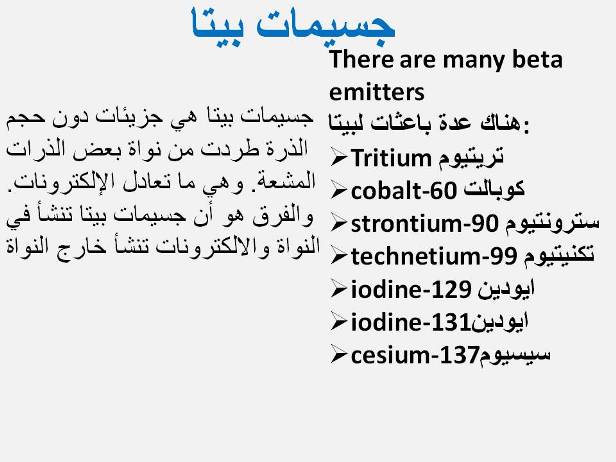| front |1 |2 |3 |4 |5 |6 |7 |8 |9 |10 |11 |12 |13 |14 |15 |16 |17 |18 |19 |20 |21 |22 |23 |24 |25 |26 |27 |28 |29 |30 |31 |32 |33 |34 |35 |36 |37 |38 |39 |40 |41 |42 |43 |44 |45 |46 |47 |48 |49 |50 |51 |52 |53| 54 | review |
 |
Beta emitters have many uses, especially in medical diagnosis, imaging, and treatment: Iodine-131 is used to treat thyroid disorders, such as cancer and graves disease (a type of hyperthyroidism) Phosphorus-32 is used in molecular biology and genetics research. Strontium-90 is used as a radioactive tracer in medical and agricultural studies. Tritium is used for life science and drug metabolism studies to ensure the safety of potential new drugs. It is also used for luminous aircraft and commercial exit signs, for luminous dials, gauges and wrist watches. Carbon-14 is a very reliable tool in dating of organic matter up to 30,000 years old. Beta emitters are also used in a variety of industrial instruments, such as industrial thickness gauges, using their weak penetrating power to measure very thin materials. Health Effects of Beta particles Beta radiation can cause both acute and chronic health effects. Acute exposures are uncommon. Contact with a strong beta source from an abandoned industrial instrument is the type of circumstance in which acute exposure could occur. Chronic effects are much more common. Chronic effects result from fairly low-level exposures over a along period of time. They develop relatively slowly (5 to 30 years for example). The main chronic health effect from radiation is cancer. When taken internally beta emitters can cause tissue damage and increase the risk of cancer. The risk of cancer increases with increasing dose. Some beta-emitters, such as carbon-14, distribute widely throughout the body. Others accumulate in specific organs and cause chronic exposures: Iodine-131 concentrates heavily in the thyroid gland. It increases the risk of thyroid cancer and other disorders. Strontium-90 accumulates in bone and teeth. |